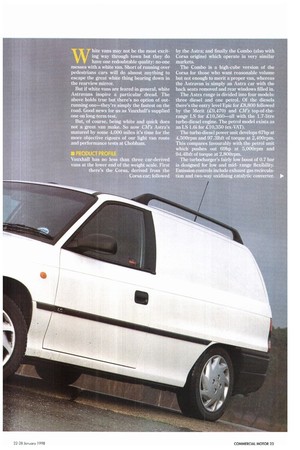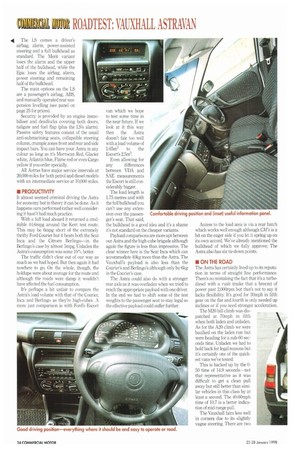1 2.112 ROADTEST: VAUXHALL ASTRAVAN W hite vans may not be
Page 24

Page 25

Page 26

Page 27

Page 28

If you've noticed an error in this article please click here to report it so we can fix it.
the most exciting way through town but they do have one redoubtable quality: no-one messes with a white van. Short of running over pedestrians cars will do almost anything to escape the great white thing bearing down in the rearview mirror.
But if white vans are feared in general, white Astravans inspire a particular dread. The above holds true but there's no option of outrunning one—they're simply the fastest on the road. Good news for us as Vauxhall's supplied one on long-term test.
But, of course, being white and quick does not a great van make. So now CM's Astra's matured by some 4,000 miles it's time for the more objective rigours of our light van route and performance tests at Chobliam.
• PRODUCT PROFILE Vauxhall has no less than three car-derived vans at the lower end of the weight scale. First there's the Corsa, derived from the Corsa car; followed by the Astra; and finally the Combo (also with Corsa origins) which operate in very similar markets.
The Combo is a high-cube version of the Coma for those who want reasonable volume but not enough to merit a proper van, whereas the Astravan is simply an Astra car with the back seats removed and rear windows filled in.
The Astra range is divided into four models: three diesel and one petrol. Of the diesels there's the entry level Epic for £8,800 followed by the Merit (.£9,470) and CM's top-of-therange LS for 1:10,560—all with the 1.7-litre turbo-diesel engine. The petrol model exists as an LS 1.6i for £10,350 (ex-VAT).
The turbo-diesel power unit develops 67hp at 4,500rpm and 97.3111ft of torque at 2,400rprti. This compares favourably with the petrol unit which pushes out 69bp at 5,000rpm and 94.4Ibft of torque at 2,800rpm.
The turbocharger's fairly low boost of 0.7 bar is designed for low and midrange flexibility. Emission controls include exhaust gas recirculation and two-way oxidising catalytic converter. 4 The LS comes a driver's airbag, alarm, power-assisted steering and a full bulkhead as standard. The Merit variant loses the alarm and the upper half of the bulkhead, while the Epic loses the airbag, alarm, power steering and remaining half of the bulkhead,
The main options on the LS are a passenger's airbag, ABS, and manually operated rear suspension levelling (see panel on page 25 for prices).
Security is provided by an engine immobiliser and deadlocks covering both doors, tailgate and fuel flap (plus the LS's alarm). Passive safety features consist of the usual anti-submarining seats, collapsible steering column, crumple zones front and rear and side impact bars. You can have your Astra in any colour as long as it's Morrocan Red, Glacier white, Atlantis blue, Flame red or even Cargo yellow if you order specially.
All Astras have major service intervals at 20,000 miles for both petrol and diesel models with an intermediate service at 10,000 miles.
• PRODUCTIVITY It almost seemed criminal driving the Astra for economy but in theory it can be done. As it happens ours performed rather well considering it hasn't had much practice.
With a full load aboard it returned a creditable 44.6mpg around the Kent test route. This may be 6mpg short of the extremely thrifty Ford Courier but it beats both the Seat Inca and the Citroen Berlingo—in the Berlingo's case by almost 5mpg. Unladen the Astra's consumption was some 10% better.
The traffic didn't clear out of our way as much as we had hoped. But then again it had nowhere to go. On the whole, though, the holdups were about average for the mute and although the roads were damp it wouldn't have affected the fuel consumption.
It's perhaps a bit unfair to compare the Astra's load volume with that of the Courier, Inca and Berlingo as they're high-cubes. A more just comparison is with Ford's Escort
van which we hope to test some time in the near future. If we look at it this way then the Astra doesn't fair too well with a load volume of 1.65m3 to the Escort's 2.5m3.
Even allowing for any differences between VDA and SAE measurements the Escort is still considerably bigger.
The load length is 1.75 metres and with the full bulkhead you can't use any extension over the passenger's seat. That said, the bulkhead is a good idea and it's a shame it's not standard on the cheaper variants.
Payload comparisons are more apt between our Astra and the high-cube brigade although again the figure is less than impressive. The clear winner here is the Seat Inca which can accommodate 40kg more than the Astra. The Vauxhall's payload is also less than the Courier's and Berlingo's although only by 6kg in the Courier's case.
The Astra could also do with a stronger rear axle as it was overladen when we tried to reach the appropriate payload with one driver. In the end we had to shift some of the test weights to the passenger seat to stay legal so the effective payload could suffer further. Access to the load area is via a rear hatch which works well enough although CM's is a bit on the eager side if you let it spring up on its own accord. We've already mentioned the bulkhead of which we fully approve; The Astra also has six tie-down points.
• ON THE ROAD The Astra has certainly lived up to its reputation in terms of straight line performance. There's no mistaking the fact that it's a turbodiesel with a rush (make that a breeze) of power past 2,000rpm but that's not to say it lacks flexibility. It's good for 30mph in fifth gear on the flat and fourth is only needed up inclines or if you need stronger acceleration.
The M20 hill climb was dispatched at 70mph in fifth when both laden and unladen. As for the A20 climb we were baulked on the laden run but were heading for a sub-60 seconds time. Unladen we had to hold back for legal reasons but it's certainly one of the quickest vans we've tested.
This is backed up by the 050 time of 14.9 seconds—not that representative as it was difficult to get a clean pull away but still better than similar vehicles in this class by at least a second. The 40-60mph time of 10.7 is a better indication of mid-range pull.
The Vauxhall fairs less well in corners due to its slightly vague steering. There are two
symptoms to this. Firstly at low speeds the Astra steers slowly so it can be quite hard work in tight spaces despite the power assistance. At higher speeds it's the vagueness which is more apparent. But once set up for a corner it behaves fine with little body roll and plenty of grip.
We preferred the ride with a full load aboard as it seemed to smooth out any vibrations coming through the steering wheel and cab which were experienced when the van was empty.
The gearshift gives no cause for concern as it's light enough but also reasonably precise.
We weren't able to test the brakes as we were faced with a wet track but a few emergency stops revealed that they lock up fairly easily and the van slewed slightly to the left both from 20mph and 30mph. That said, they're fine around town if a little lifeless.
• CAB COMFORT Being essentially a car it's no surprise that the Astravan has good levels of driver comfort. The seats are firm and give excellent support over long journeys. They're also fully adjustable with the inclusion of a height control which also contributes to a good driving position.
Ergonomically the Astra works well too. The handbrake lever anti gear shift are in the right place as are the stalks for indicators and washers. The dials are easy to read—the red indicator for 30mph is particularly useful.
One unusual feature in a van is the display panel above the radio. This tells you such liferelevant information such as the time, which radio station you're listening to and even the outside temperature.
The Astra is quite a noisy van compared 10.
.41 with others in its class and a lot of this noise comes from the load area. Fortunately the rear speakers have been carried over from the car and if you operate the stereo on these alone it goes some way to masking the din.
Stowage space is kept to a minimum. There's a glovebox (with cup holders in the lid), and door pockets. Finally visibility is a strong point in the Astra. The wing mirrors are a decent size and the wide-angle section on the driver's side is a further boon.
• SUMMARY
Speed and frugality are two sought-after qualities for most van drivers and in these two areas the Astra scores highly The payload is good enough and although the load volume appears to be smaller than the Escort's it's rare to load a vehicle of this sort to the gills, The cab is a pleasant place to be in and wouldn't tire long-distance drivers.
The Astravan is a solid all round vehicle which does many things well, without shining in any particular area, and has a few faultsnone of them serious, The ultimate comparison should be between with the Escort, which we hope to test later in the year
0 by Charles Young Power house: The 1,700cc four-pot turbo-diesel unit develops 67hp and 9716ft of torque.
Price as tested: £10,985 ex-VAT.
Engine: 1.7-Litre, 67hp (50kW) turbo-diesel. GVW: 1,680kg. Payload: 509kg.
Fuel consumption (laden): 44.6mpg (6.3 lit/100km).
SPECIFICATION
Vauxhall Astravan 1 7TD. Design GVW: 1,680kg. MODEL Importer: Vauxhall Motors Limited, Luton LU1 3r.
EMei Turbochargedindirect-iniection four-stroke diesel, with exhaust gas recirculation and an oxidation catalyst. Cylinders: Four, in line, mounted transversely. Born/stroke:132.5x79.5mm Capacity:1,700cc.
Compression ratio: 22:1.
Maximum net power: 67hp150kW) at 4,50Orpm. Maximum net torque: 97.3Ibft(132Nm) cit 2,400rpm.
TRANSMISSION
Ratios: 3 73, 1.96, 1.31, 0.95, 0 76:1. Clutch: Single dry plate.
BRAKING SYSTEMS: Front, ventilated discs, rear, self ad.J.stIng claims BEEM Rock and pinion system.
ISMia Suspension: Front, Independent MacPherson struts with gas dampers, coil springs, anti-roll bar; rear, compound crank with progressive rate mini block coil springs, gas dampers and anti-roll bar.
Axle design weights: Front, 820kg; rear, 960kg.
Design GTW: 900kg.
Wheels and tyres: Steel wheels, Michelin tyres 175/65 xl 4. Fuel tank: 50 litres.
ELECTRICAL SYSTEMS: Battery, 60Ah; otterriatar, 70A.
TERMS OF WARRANTY 12 months' unlimited distance with six years' anft-perforottor warranty.
DEALERS AND SERVICE POINTS Vauxhall has 500 dealers in the UK.
FEATURES Standard Driver's airbag Alarm with rnicrophonics
Power-assisted steering
Full bulkhead (half steel, half mesh)
Optional extras [ex-VAT)
Passenger's airbag £285 ABS £555 Rear suspension levelling £145 OPERATIONAL TRIAL RESULTS
Kent test route: 140.6km (65.5km Motorway/75,1km A-rood).
Average speed: Laden, 64.4km/h (40.3mph); Unladen: 67.0km/h (41.8mph).
Average fuel consumption: Laden, 44.6mpg (6.3 lit/100km); unladen, 48.9mpg (5.81it/100km).
ACCELERATION WEIGHTS
Kerbweight (with 75k9 driver) 1,171kg
Net payload 509kg
Total 1,680kg
IN-CAB NOISE
km/h dB(A) Tickover
55 48 69
64
74 80 73 96
74 112 78 BRAKE PERFORMANCE
Brakes were unable to be tested due to a wet test track.
Park brake held on 33% (1-in-3) gradient facing up and downhill.
HILL PERFORMANCE
Hill min sec
M20 2 AO
A20 0 56 Restart not possible on 33% (1 -in-3) gradient
TURNING CIRCLE
Kerb to kerb 9.8m Steering 3.5 turns lock-to-lock






































































































